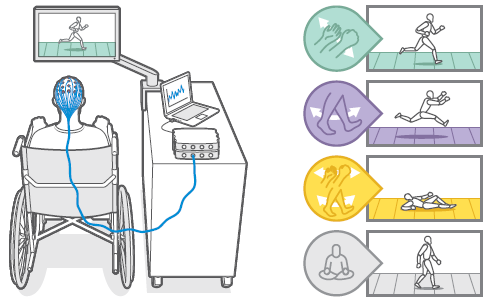What Should We Learn From? How Paralysed Athletes Used a Brain-computer Interface to Win Gold at the Cyborg Olympics

In October 2016, inside a sold-out arena in Zurich, a man named Numa Poujouly steered his wheelchair up to the central podium. The 30-yearold, who became paralyzed after a bicycle accident in his teens, had triumphed in the tournament’s most futuristic event: a video-game-like race in which the competitors controlled their speeding avatars with just their minds.
The Cybathlon was created as a bionic version of the Paralympic Games. The visionaries behind the Cybathlon, led by Robert Riener of the Swiss Federal Institute of Technology (ETH), in Zurich, had several objectives. First, taking a page from the XPrize Foundation, they wanted to use competition to accelerate the development of assistive technologies. The organizers also wanted end users of the technology to work alongside engineers, clinicians, and entrepreneurs in designing the gear. Finally, they wanted to raise awareness of cutting-edge technologies that may soon give people with disabilities remarkable abilities.
The group in the brain-machine interface lab at the other Swiss Federal Institute of Technology (EPFL), in Geneva, fielded the Brain Tweakers team to compete in the Cybathlon’s Brain-Computer Interface (BCI) Race. As with any BCI system, signals recorded from the pilot’s brain were fed into a decoding algorithm that translated the signals into commands. In this case, the commands were used to control the pilot’s avatar, but other BCI systems could be used by people with severe motor impairments to control a variety of devices—including wheelchairs, prosthetic limbs, and computer cursors.
The authors of the paper entitled How Paralysed Athletes Used a Brain-computer Interface to Win Gold at the Cyborg Olympics published in IEEE Spectrum, Sep. 2017, discuss the related problems. They hope that such technology could be transfered from the lab to the home even there are several more factors should be considered in the future. Both of the Cybathlon pilots are enthusiastic about the future of BCIs and imagine a wide range of uses that will give them more autonomy in their daily lives. The authors, the Brain Tweakers engineers, are dedicated to making the technology that will be one part of the equation.
Serafeim Perdikis, Luca Tonin & José del R. Millán. How Paralysed Athletes Used a Brain-computer Interface to Win Gold at the Cyborg Olympics. IEEE Spectrum, Sep. 2017, pp. 44-51

